How would you survive in a war-torn country, where bombs could potentially fall from the sky with only very short notice? And what if the bomb in question were The Bomb — a nuclear weapon? This concern is thankfully distant for most of us, but it wasn’t always so. Only 75 years ago, bombs were raining down on England, and until much more recently the threat of global thermonuclear war was encouraging school kids to “duck and cover”. How do you protect people in these situations?
The answers, naturally, depend on the conditions at hand. In Britain before the war, money was scarce and many houses didn’t have basements or yards that were large enough to build a family-sized bomb shelter in, and they had to improvise. In Cold War America, building bomb shelters ended up as a boon for the swimming pool construction industry. In both cases, bomb shelters proved to be a test of engineering ingenuity and DIY gumption, attempting to save lives in the face of difficult-to-quantify danger from above.
Anderson and Morrison
If you are a well-funded construction company making a bunker for some General or politicians, setting up a bomb shelter isn’t that hard. Find some land, buy it, excavate, pour concrete, and spend what you want on things like air conditioning and furniture. The equation is different, though, if you need to make lots of shelters to fit in peoples’ modest yards using simple materials. Homes in the UK rarely have cellars or basements, and even so, basements became death traps in the aggressive bombing during the war.
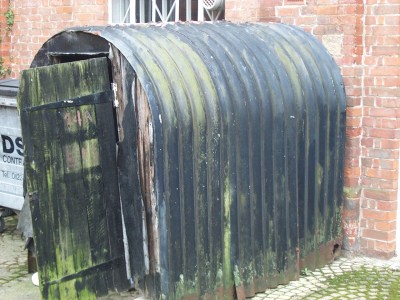 Just before the UK joined WWII, Lord Privy Seal Anderson was in charge of preparing for air attack. He turned to two men, William Patterson and Karl Kerrison, to come up with a practical solution. The so-called Anderson shelter was little more than some corrugated steel panels. Of the fourteen panels, some were curved and some were straight. The shelters were very effective because they’d be covered with dirt or sandbags.
Just before the UK joined WWII, Lord Privy Seal Anderson was in charge of preparing for air attack. He turned to two men, William Patterson and Karl Kerrison, to come up with a practical solution. The so-called Anderson shelter was little more than some corrugated steel panels. Of the fourteen panels, some were curved and some were straight. The shelters were very effective because they’d be covered with dirt or sandbags.
You can see they weren’t spacious. An Anderson was about six feet long, a bit over six feet high and about four and a half feet wide. If you didn’t make much money, you got one for free. Most people had to pay a nominal sum for one, though.
What you did with the inside of your shelter was up to you. As you might expect, there was quite a bit of variation.
One common problem with the shelters, though, was that they were cold. No shelter will protect a family that won’t go in it, so the British government had some advice about staying warm. Ultimately, though, they developed the Morrison shelter. Although only a few of the three million or so Anderson shelters went into homes with sandbags, the Morrison shelter was strictly an indoor affair.
The Morrison shelter looked like a table with a crawl space underneath. In fact, it could be used as a table. John Baker, the designer, knew it would be impossible to shield against a direct hit under his design constraints, so he focused on mitigating common bomb-related deaths, such as roof collapses. The shelter took its name from the Minister of Home Security, Herbert Morrison and — honestly — reminds us of a rabbit cage.
There were other shelter types, too, as well as people taking refuge in tunnels such as the Underground. Some people were saved, but there were many cases of people in shelters dying.
Across the Channel
The Germans learned that basements — a common feature in German homes — were not good places to wait out a bombing. So they built Hochbunkers — high rise bunkers completely above ground. These structures had very thick walls up to 1.5 m thick.
These shelters might seem unlikely, but they were pretty successful. Attempts to destroy them on purpose after the war proved difficult, so many of them are still around being used for schools, offices, and storage space. The video below shows a Hochbunker in Munich that now serves as an apartment complex.
Duck and Cover in Your New Pool
If you think your Anderson shelter won’t survive a direct hit from a conventional bomb, imagine a direct hit from a nuclear one. However, during the Cold War, people were building fallout shelters. The idea is that you might survive a moderately nearby nuclear blast only to be killed by fallout up to a few weeks later. However, if you had a place to hang out for a few weeks, you might survive to rebuild civilization or destroy post-apocalyptic zombies or whatever.
It was so easy to build that even old Walt could do it — at least according to the concrete masonry industry in the film below. If you had a basement it was pretty easy to refit it and you could use the space as a bizarre guest room or a darkroom as the excited actors in that little drama continually point out.
If you want to read the books that Walt shows, there are quite a few copies of the Family Fallout Shelter guide floating around. We couldn’t find “Mr. Atom and his Sinister Blanket”, other than a few pictures from an auction and as a brief part of a historical video on the National Concrete Masonry Association (look around the 9:50 mark). We actually talked about Walt a few years ago.
In America as in Britain, in many parts of the country people don’t have basements. In that case, you need to dig out a fallout shelter, and that’s too much work for most people. The answer? Hire someone with an excavator to do it, so pool contractors got in on the act. Vice-versa, in other areas, contractors who set up to do excavations to capitalize on the fallout shelter craze turned to building pools once the shelter business started — no pun intended — drying up.
Of course, most people didn’t build their own shelters: they were going to go to the local Civil Defense shelter. According to experts, that wouldn’t have worked if there had been a real war. It is hard to remember just how afraid everyone was over a sudden and massive nuclear strike during the cold war. We had CONELRAD and bright yellow Geiger counters. Some of the things were maybe to make you feel better even if they weren’t totally effective.
Today we have preppers building bunkers against the upcoming collapse of society, which isn’t too different. Maybe our grandkids will be building bunkers against the alien hoard that is bound to show up at any time now. Of course, if you have a lot of spare cash, you could score a pretty sweet five-bedroom bunker with all the amenities.
Photo credit: Hochbunker photo Creative Commons SA 3.0 by [Stefan Kühn]

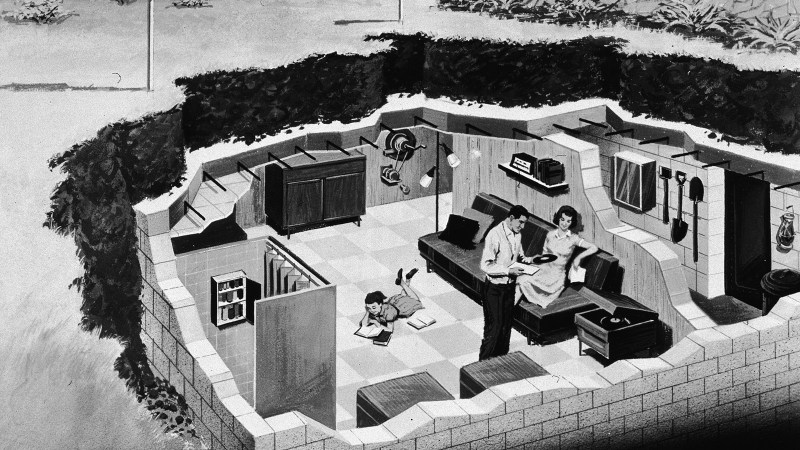
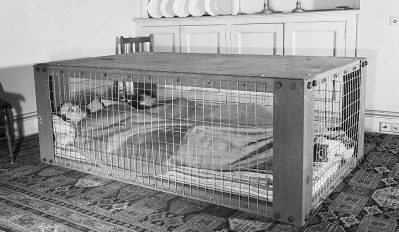
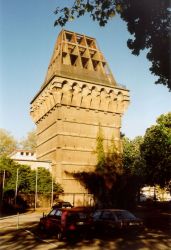
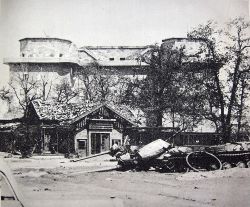
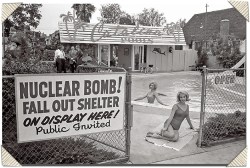















Now days some need the Morrison Shelter more like a Anechoic Chamber and/or Faraday Cage seems:
https://hackaday.com/2018/12/14/build-your-own-anechoic-chamber/
https://hackaday.com/2018/09/26/building-a-hardware-store-faraday-cage/
” Lord Privy Seal Anderson ”
Uh, huh.
There’s one reason to build a shelter and it has nothing to do with war, or civil unrest. Environmental disasters like tornadoes, and maybe even forest fires.
“Lord Privy Seal” was not his name, it was his job title – https://en.wikipedia.org/wiki/Great_Officer_of_State
He was https://en.wikipedia.org/wiki/John_Anderson,_1st_Viscount_Waverley
Also, the UK doesn’t really get evacuation-level environmental disasters.
I was aware it was his title but not sure what the form of address was. A peer would be like Sir John. But you don’t say, for example, prime minister Winston. So….
So, it wasn’t his job to make sure that privys i.e.outhouses (dry loos -Jenny) were properly sealed?
Twilight Zone, 1961 – The Shelter.
I was 10. Not a fun time.
If you want to prep for a collapse of society look at 90s Russia. People with regular jobs got absolutely wrecked when state stopped working. People who stole infrastructure for scrap metal, traders, moonshiners flourished and went on to become oligarchs in 2000s Russia.
Nope. Mid level Communist party functionaries and state security apparatchics who were in a position to gain legal conrol of industries and resources they administered went on to become oligarchs. Metal thieves, traders and moonshiners are still down at that level.
“The idea is that you might survive a moderately nearby nuclear blast only to be killed by fallout up to a few weeks later.”
The real deal is that population centers weren’t the primary targets – military installations and infrastructure were. ICBM bases, command/control centers, nuclear storage, etc. So as a civilian if you were reasonably far away from those you just had to deal with fallout.
As a child in the ’70s, it was semi-comforting to live within a few miles of a primary target – at least I knew all the horrors of post-apocalyptic war weren’t going to affect me.
No kidding! While it might be fun to play a game like fallout, actual survival in such circumstances is bound to be a nightmare.
The challenge of scavenging and cobbling together things would be something most of us here would happily participate in, but the collapse of society and the resultant slavery, thievery, etc. wouldn’t be something that I would want to deal with. Spend time hanging out with hardcore preppers and you may decide that you wouldn’t want to live like that.
Nobody will be forcing you to survive (except for yourself). You’re allowed to give up.
That’s some dark sh*t lol
Population centres might not be primary targets, but some of those targets were/are in the middle of towns and cities.
I grew up near Cheltenham, which is home to GCHQ (the UK’s version of the NSA), and surely that was (is) a target.
We lived just far enough away that even an off target bomb would probably miss us, but definitely close enough to catch a lot of fallout. My parents didn’t bother with a shelter, they knew there was no point, they just made sure to have a way to end our lives quickly and painlessly, which is a hell of a thing for a parent to have to think about for their kids.
Is that a carbon tetra-fluoride fire extinguisher hanging by the entrance of the shelter in the banner photo?
I’m still trying to figure out what the crank thingy upper-center is.
It’s a generator for electricity (for the light, I assume).
See the last photo of this article: https://www.history.com/news/nuclear-fallout-shelters-were-never-going-to-work
Probably representative of a Kearney Air Pump — necessary to keep you from suffocating while in a shelter.
https://www.oism.org/nwss/s73p917.htm
^this^
It is probably a filtered air intake. They had an electrical punp but also a manual cranc in case the generator ran out of fuel. The larger bunkers also had a compressed air storage for one or two days.
Spent my military service during the cold war in a few bunkers that had these.
That was in the Netherlands in the 80’s , and yes I was a primary target :-)
I think I see a petroleum/kerosene lamp hanging there and a big waste bin standing on the ground.
People think of fallout shelters as something from the 50s or 60s. But somewhere I have a booklet on construction that I got from the local courthouse in the early 80s.
Have a look how Hochbunkers looks like today, after failed attempts to destroy them using explosives:
The “Monte Pinnow” in Sande right next to the train station, near Wilhelmshaven, Germany has tilted by 18° and is now used by the Wilhelmshaven section of the German Alpine Club (“Deutscher Alpenverein”) to train climbing. – https://www.google.com/search?q=monte+pinnow&source=lnms&tbm=isch
Also near Wilhelmshaven, in Langewerth, is another Hochbunker where the explosion in 1949 has pressed the walls outwards, and the shelter has sunken into the weak ground by more than two meters. It still stands, in 2019. – http://www.luftschutzbunker-wilhelmshaven.de/bu_sites/langewe.html
Wilhelmshaven was founded in 1869 as a naval base, named after William I of Prussia. It features a harbour with very deep water, nearly independant of tides, safe even during heavy storms, and easy to defend against forces coming from the north sea. Before and during World War II, Wilhelmshaven was of course used as harbour for the navy, and a lot of supporting industry was placed in and around Whilhelmshaven. So, Wilhelmshaven became an important target for british and american air forces. Many shelters were build, and many of them can still be found in the area, mostly unused, with entrances locked up or walled up.
Another Hochbunker was build in Sanderbusch, again near Wilhelmshaven, as part of the Sanderbusch hospital. It was used during WW II as an auxillary hospital. Unlike the others, no attempt was made to destory after WW II. During cold war, the equipment was modernized. The technical equipment is still in place and could easily be re-activated if needed. – https://de.wikipedia.org/wiki/Nordwest-Krankenhaus_Sanderbusch
Nice!
Thanks for the links!
This dude bought a Titan II shelter, a former nuclear missile silo
:o)
https://www.youtube.com/watch?v=EfTfcdL4qlE
Living in a former missile base seems great, until you realize what it is going to cost initially for asbestos abatement, PCB cleanup, lead paint removal, and the continuing cost of ventilation and running sump pumps.
In the town I live in there are quite a few missile silos around (Old US airforce base nearby) These are smaller silos for anti-aircraft and anti-missile missiles, so they are horizontal load (Is that the right word?) and about th size of a small barn. Most are used as barns. Somthing like that is still relatively cheap and small while still being more than capable of surviving direct (non-nuclear) blasts.
alien hoard => alien horde
Who knows, maybe Al thinks we’re all going to be crushed by a giant alien’s giant nest egg.
https://www.dictionary.com/browse/hoard
I don’t think Jane Fonda is an alien, (at least in the U.S.)
(referring to an old Cheech and Chong skit)
B^)
https://www.history.com/news/nuclear-fallout-shelters-were-never-going-to-work Pure horseshit.
Opium for the masses.
I think old tyres (tires for the US readers) used with earthship style building techniques could be very effective for a bunker.
Now I kind of want to go home and watch Blast From the Past when I get off work.
I always remember an US couple crazy for the 2012 end of the world that came to a nearby town called Olmué to make their end of the world shelter ñ
They bought a complete Hill and made a house over it. Spent millions of dollars in material and design. They started to build hiring people. At some point of early 2012 one of the workers died in an accident working at the house. Police locked the house a month later investigating what was happening there, why the house over a bunker why so expensive ventilation systems. So deeper investigation started to check if this will be some kind of cocaine laboratory or something like that. The date arrived, with the house finished, but the couple never arrived. There wasn’t any end of the world, they had to compensate worker’s family, they never came to live in that house. Now that shelter is abandoned and no matter how cheap are they selling it, nobody wants to buy that house. People not only think that is weird, also they think that is cursed.
As I understand it, this is the house you mention?
https://www.soychile.cl/Quillota/Sociedad/2018/07/21/546044/Llamado-a-remate-de-bunker-de-Olmue-no-tuvo-postores.aspx
Machine translation of the article follows.
At 09:45 yesterday the auction of the property called “bunker of the end of the world” was going to take place, in Olmué, however, the third call for auction of the property could not materialize because it had no bidders and it was not reached the minimum posture of $ 400 million.
The El Llano sector property was built in order to enable an organic farm on site by a couple of US retirees, and was initially valued at $ 1.2 billion. The auction sought to cover salaries, compensation and other payments due to workers who were part of the construction, according to El Mercurio de Valparaíso.
In addition, the place saves the tragic death of Nicolás Silva (19 years old), the product of an electrocution while working there. Your family is owed compensation in excess of $ 200 million.
In another month, a fourth call for auction will be held, but this time without a minimum amount for bidders.
Source: soychile.cl – https://www.soychile.cl/Quillota/Sociedad/2018/07/21/546044/Llamado-a-remate-de-bunker-de-Olmue-no-tenido-postores.aspx
Some images from Gooooooogul…
https://www.google.com/search?q=Olmu%C3%A9&client=firefox-b-1-e&tbm=isch&tbs=rimg:CR_1epymJqYtcIjht0GCBW7lxswD74NqWiEcYPnP9eJLupxdOKBPD1r-uHvgWceGZerSUKk8xnsqaSt1v0DSXi8trNioSCW3QYIFbuXGzEeohzfaxWWsvKhIJAPvg2paIRxgRVSgR083nrHYqEgk-c_114ku6nFxEPkQsAzXSmzCoSCU4oE8PWv64eEUU7uOBXu2pbKhIJ-BZx4Zl6tJQR0ydgXoWRejgqEgkqTzGeyppK3RGKjhtmiXIzdSoSCW_1QNJeLy2s2EYF0t4e7mAv-&tbo=u&sa=X&ved=2ahUKEwiIr4q7mcHjAhWFZM0KHcpBDkoQ9C96BAgBEBg&biw=1392&bih=776&dpr=1
Dang, are they still offering that price on that fallout shelter? 1500 is a steal for a subterranean studio apartment.
Okay, new capitalism-is-broken app idea: rent out your unused bay area fallout shelters
Air-raid-bnb
The scale of the problem has grown with the yield of the weapons over the years. 20 yrs ago the weapon yields grew large enough that a ground burst would leave a crater with a 40 mile radius, and the first few survivors would be at about double that radius. This was at the same time that the total number of weapons had risen to allow inclusion of a great many lower priority targets as well, nearly complete coverage. There will still be a few survivors… that might escape the fallout… and carry on the race.
About 30 years ago I spent a few nights inside a collective shelter in Lausanne, Switzerland, with a bunch of european students. Fortunately we spent the day hours outside. The toilets were clogged after two days, there was no real space inside, everything was very depressive, like no external sound at all. While it was an impressive building, it did not seem possible to spend a long time there. By law, every building / house in Switzerland has its own nuclear fall-out shelter !
Here’s a current design that isn’t quite bomb proof but easily could be. And its designed for passive heating and cooling!
https://richsoil.com/wofati.jsp
A farm family moved into town when the kids reached school age.Dad proceeded to build a tornado shelter, and the neighbors made fun of it. One day when dad cam home for lunch, the warning siren where going off. Dad went to the shelter to see if the family where in it. They where along with so many neighbors there was no room for dad.